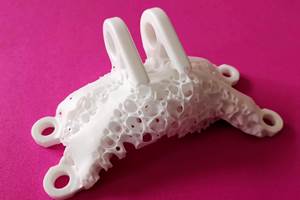Sigma Additive Solutions Creates Software Module for Standardizing Machine Health Data Logs
This next-generation open architecture offering can streamline processes, advance digital quality workflows and enable additive industry users to gain consistency across their sites and supply chains.
Share
Sigma Additive Solutions (Sigma) has developed a software module for standardizing machine health data logs. This next-generation open architecture offering can streamline processes, advance digital quality workflows and enable additive industry users to gain consistency across their sites and supply chains
The company, a developer of quality assurance software for the commercial 3D printing industry, is releasing a beta version of its PrintRite3D Machine Health module. This solution marks the beginning of the company’s software-only approach to quality assurance by enabling users to take disparate machine log files and standardize them. Built upon Sigma’s PrintRite3D monitoring and analytics technology, the company is creating a framework for connecting and standardizing distinct sensors and images into a cohesive product suite.
Features of the new solution include a path to scale for integrated sensor fusion of camera, thermal camera, melt pool data and more; ability to link machines by API or upload all machine sensor .csv log files; and creation of a common standards-based file format for analytics, visualization, and reporting, agnostic of machine type.
It also includes a single cohesive environment for all in-process quality data, customizable to unique production requirements; deep insight, analytics and reporting of machine sensor data; and dashboard visualization showing key metrics.
“This is an exciting announcement, not only for Sigma, but for the entire additive industry,” says Jacob Brunsberg, Sigma’s president and CEO. “Today, proprietary quality control approaches of various additive machine manufacturers often lead to inconsistency in quality assurance across manufacturing operations. The objective of the initial module — and all future modules — is to help drive a standards-based approach to additive manufacturing, allowing users to gain consistency across their sites and supply chains. Allowing users to take disparate machine log files and standardize them is an important first step in connecting distinct sensors and images into a cohesive product suite.”
Users say a truly holistic approach to quality is just what the industry needs. “As a member of the Sigma Additive Product Advisory Council, I am thrilled to have early access to the launch of the Machine Health and future modules, and to put them to work in our facility,” says Ivan Madera, Morf3D CEO. “Standardizing machine logs will streamline processes and advance digital quality workflows. Having a single interface, streaming data from all connected machines, moves the industry forward into a digital future and away from hours of work from manually collecting, converting, processing and analyzing all the individual aspects of quality.”
The company says sensor fusion — conjoining data types — will provide improved confidence in defect detection, root cause analysis and mitigation, enabling everyone to interpret control charts and other data types/sources uniformly. “Our engineering team has spent over 10 years developing the technology to provide a framework for standards-based data exchange, metrics and analytics,” says Darren Beckett, Sigma CTO. “We are committed to an open architecture philosophy and acting as a third-party agnostic option, connectable to the broader installed base of the additive industry.”
-
Read about Sigma’s partnership with Materialise that combines the Materialise Control Platform (MCP) and Sigma Labs’ PrintRite3D sensor technology to enable users to identify and correct metal build issues in real-time.
- Learn how Sigma launched an engineering collaboration with Additive Industries to provide in-process melt-pool monitoring on a four full-field laser system.
Related Content
Spherene Creates Metamaterial with Geometry Derived from Spheres
An algorithm developed by Spherene Inc. generates Adaptive Density Minimal Surfaces (ADMS) as a self-supporting infill strategy that can be used to reduce mass and manage material properties in 3D printed parts.
Read MoreAircraft Engine MRO: How Additive Manufacturing Plus Robotic Finishing Will Expand Capacity for Blade Repair
AM offers the chance to bring fast, automated processing to individualized, part-by-part restoration of turbomachinery. A cell developed by Acme Manufacturing and Optomec is able to automatically repair 85,000 unique aircraft engine blades per year.
Read MoreActivArmor Casts and Splints Are Shifting to Point-of-Care 3D Printing
ActivArmor offers individualized, 3D printed casts and splints for various diagnoses. The company is in the process of shifting to point-of-care printing and aims to promote positive healing outcomes and improved hygienics with customized support devices.
Read MoreCopper, New Metal Printing Processes, Upgrades Based on Software and More from Formnext 2023: AM Radio #46
Formnext 2023 showed that additive manufacturing may be maturing, but it is certainly not stagnant. In this episode, we dive into observations around technology enhancements, new processes and materials, robots, sustainability and more trends from the show.
Read MoreRead Next
At General Atomics, Do Unmanned Aerial Systems Reveal the Future of Aircraft Manufacturing?
The maker of the Predator and SkyGuardian remote aircraft can implement additive manufacturing more rapidly and widely than the makers of other types of planes. The role of 3D printing in current and future UAS components hints at how far AM can go to save cost and time in aircraft production and design.
Read More4 Ways the Education and Training Challenge Is Different for Additive Manufacturing
The advance of additive manufacturing means we need more professionals educated in AM technology.
Read More3D Printing Brings Sustainability, Accessibility to Glass Manufacturing
Australian startup Maple Glass Printing has developed a process for extruding glass into artwork, lab implements and architectural elements. Along the way, the company has also found more efficient ways of recycling this material.
Read More




















